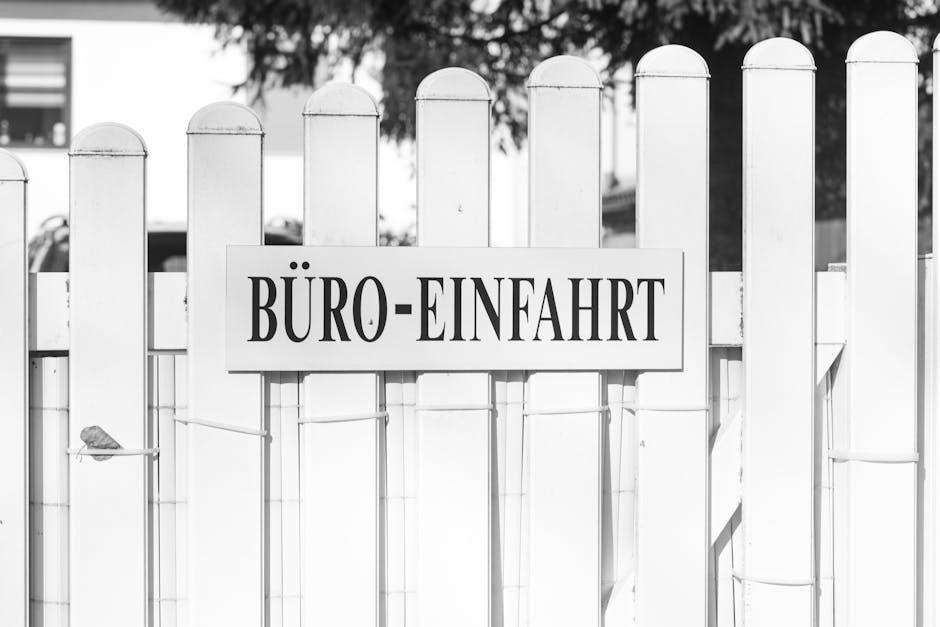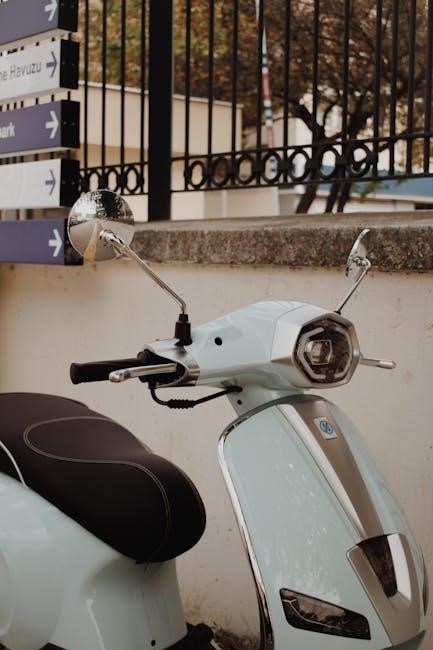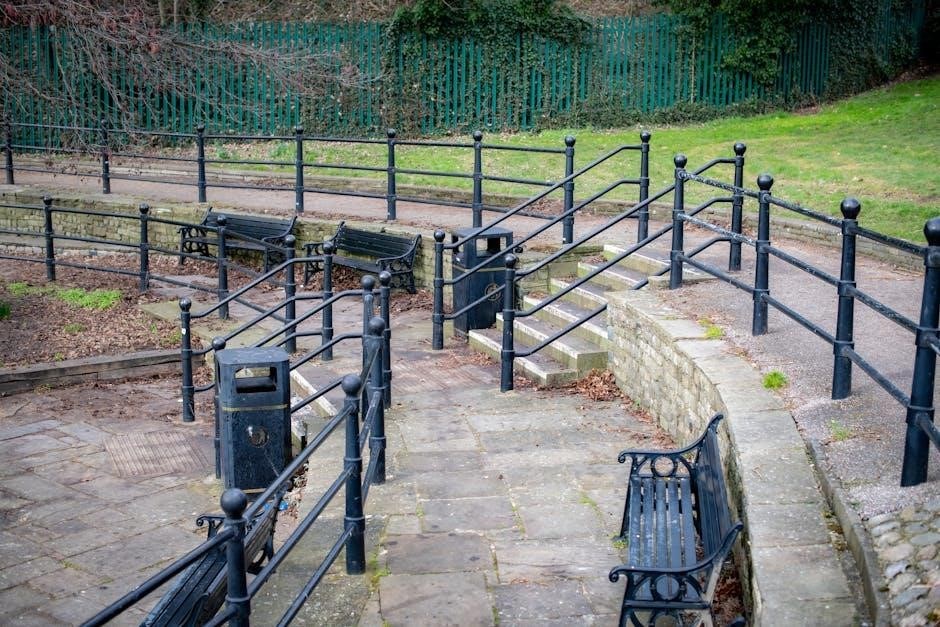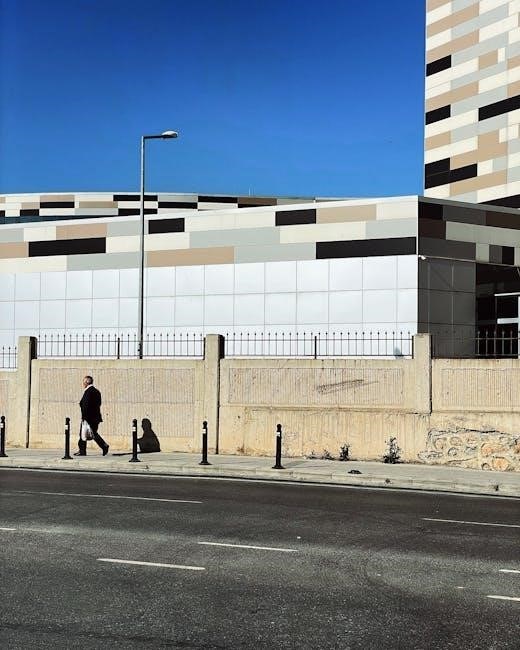
Heras fencing is a widely used temporary fencing solution, essential for construction sites and events. This guide explores its design principles, safety, and regulatory compliance.
Overview of Heras Fencing
Heras fencing refers to temporary fencing systems designed for versatility and durability. Commonly used in construction sites, events, and urban projects, it provides secure boundary solutions. Made from high-quality materials like steel or plastic, Heras fencing is lightweight yet robust, making it easy to install and transport. Its modular design allows for customization to suit various site requirements. Widely recognized for its reliability, Heras fencing is a popular choice for temporary works, ensuring safety and efficiency in diverse environments. This guide delves into its design, installation, and compliance with industry standards, offering practical insights for professionals and site managers.
Importance of Temporary Works Design
Temporary works design is crucial for ensuring safety, stability, and efficiency in construction and event settings. Proper design prevents structural failures, protecting people and property. It also ensures compliance with legal and safety standards, minimizing risks and liabilities. Effective temporary works design optimizes resource use, reducing costs and environmental impact. By addressing site-specific challenges, it enhances project planning and execution. This guide emphasizes the significance of robust design principles in temporary fencing solutions, providing insights to practitioners for achieving safe and efficient outcomes in various applications.
Scope of the Article
This article provides a comprehensive overview of Heras fencing temporary works design, focusing on key principles, safety, and compliance. It explores the structural integrity, site-specific requirements, and environmental considerations. The guide covers design elements, installation best practices, and maintenance procedures. It also addresses safety precautions, risk management, and regulatory compliance. Intended for practitioners, contractors, and site managers, the article offers practical insights and real-world applications. By examining case studies and lessons learned, it aims to enhance understanding and implementation of effective temporary fencing solutions. This resource serves as a detailed reference for ensuring safe, efficient, and compliant temporary works design in various settings.

Key Considerations in Temporary Works Design
Load calculations, site-specific requirements, safety measures, and environmental factors are critical. Compliance with standards ensures structural integrity and protection for people and surroundings.
Load Calculations and Structural Integrity
Load calculations are fundamental to ensuring the stability and safety of Heras fencing systems. These calculations consider factors such as wind load, weight distribution, and site-specific conditions. Structural integrity is maintained by using high-quality materials and adhering to design specifications. Proper installation ensures the fencing can withstand external forces without compromising safety. Design formulas and testing protocols are essential to validate the system’s performance under various loads. Compliance with engineering standards guarantees reliability and durability, minimizing risks of failure. Regular inspections further ensure that the temporary works remain structurally sound throughout their deployment. This combination of precise calculations and robust construction ensures Heras fencing systems are both safe and reliable for temporary applications.

Site-Specific Analysis and Requirements
Site-specific analysis is critical for determining the suitability of Heras fencing in various environments. Factors such as soil type, ground level variations, and environmental conditions must be assessed to ensure stability. Local regulations and permits often dictate specific design and placement requirements. Understanding these elements enables tailored solutions that meet both functional and compliance needs. This analysis ensures the fencing system is adapted to unique site challenges, enhancing safety and effectiveness. Proper planning and adherence to site-specific guidelines are essential for successful temporary works deployment. This step ensures that Heras fencing performs reliably under diverse conditions, making it a versatile choice for temporary applications.
Environmental and Safety Factors
Environmental and safety factors are paramount in Heras fencing temporary works design. Ensuring minimal ecological impact is crucial, with measures like ground protection and waste reduction. Safety considerations include visibility, accessibility, and emergency egress. Heras fencing systems are designed to prevent tripping hazards and ensure clear pathways. Compliance with health and safety regulations, such as ISO 9001 and ISO 14001, underscores their commitment to environmental stewardship and worker safety. Durable materials and secure installation methods enhance stability, reducing risks of collapse. Regular inspections and maintenance further mitigate potential hazards, ensuring a safe and sustainable temporary fencing solution for various applications. This holistic approach addresses both environmental and safety concerns effectively.

Design Elements of Heras Fencing
Heras fencing incorporates durable panels, sturdy bases, and reinforced stability systems, ensuring robust temporary structures that meet site demands and safety standards effectively.
Panel Dimensions and Specifications
Heras fencing panels are typically 3.5m wide and 2m high, constructed from durable steel with a galvanized or PVC coating for rust resistance. Each panel weighs approximately 35kg, ensuring stability while allowing easy handling. The frame and mesh design provides excellent strength and visibility, with horizontal and vertical wires spaced for optimal security. Panels are designed to connect seamlessly, forming a continuous barrier. They are compatible with various bases and stabilizers, enhancing versatility for different site conditions. These specifications ensure Heras panels meet safety and structural requirements, making them ideal for temporary fencing in construction and event settings. Their standardized dimensions facilitate efficient installation and relocation.
Base and Footing Requirements
Heras fencing systems require robust base and footing solutions to ensure stability and safety. Typically, concrete or steel bases are used, weighing between 22kg and 30kg, depending on the application. These bases are designed to distribute the weight evenly, preventing the fence from toppling. Footings may need to be extended or reinforced for soft or uneven ground to maintain structural integrity. The connection between panels and bases is critical, often secured with clips or bolts. Proper alignment and leveling are essential to avoid weak points. Ground conditions, such as soil type and moisture, must be considered to determine the appropriate footing depth and type. Compliance with safety standards ensures the system remains secure under various conditions.
Stability and Reinforcement Systems
Stability is crucial for Heras fencing to withstand external forces like wind and site activity. Reinforcement systems, such as counterweights or ground anchors, are often employed to enhance stability. These systems distribute weight evenly, preventing toppling and ensuring the structure remains upright. Additionally, fencing panels can be reinforced with brackets or struts, especially in high-risk areas. Regular testing and inspections are recommended to ensure the system’s integrity. Compliance with safety standards guarantees that the fencing remains stable under varying conditions, protecting people and property effectively. Properly implemented reinforcement systems are vital for maintaining the structural reliability of temporary fencing solutions in diverse environments.
Compliance with Standards and Regulations
Adhering to international and British standards ensures Heras fencing meets safety and structural requirements. Compliance with site-specific regulations guarantees secure and reliable temporary fencing solutions.
International Standards for Temporary Fencing
International standards for temporary fencing ensure uniform quality and safety globally. These standards address material specifications, structural integrity, and safety features. Heras fencing aligns with these guidelines, ensuring durability and reliability in various environments. Compliance with international norms guarantees that temporary fencing solutions meet rigorous testing and performance criteria, making them suitable for diverse applications. Adherence to these standards also promotes consistency across industries, ensuring that temporary fencing systems provide secure and stable solutions for construction sites, events, and other temporary requirements. By following international standards, Heras fencing delivers trusted performance, meeting the expectations of global clients and regulatory bodies. This ensures safety and efficiency in temporary works design.
British Standards for Temporary Works
British Standards provide a framework for ensuring the safety and structural integrity of temporary works, including Heras fencing. Standards such as BS 5975 and BS EN 13374 outline specific requirements for the design, installation, and maintenance of temporary fencing systems. These guidelines ensure that temporary fencing meets safety, durability, and performance criteria, aligning with UK construction industry expectations. Compliance with British Standards is crucial for guaranteeing the reliability of temporary works, particularly in construction and event settings. Heras fencing, designed to meet these standards, offers a robust and secure solution for temporary site requirements, ensuring safety and minimizing risks for personnel and the public. Adherence to these standards underpins the quality and reliability of Heras fencing solutions.
Local Authority and Site-Specific Compliance
Ensuring compliance with local authority regulations and site-specific requirements is critical when designing temporary works with Heras fencing. Local authorities often impose unique conditions based on location, environmental factors, and community needs. Site-specific assessments must consider factors such as ground conditions, wind loads, and pedestrian or vehicular traffic. Environmental considerations, such as noise restrictions or wildlife protection, may also influence design choices. Compliance may involve obtaining permits or adhering to local bylaws, ensuring temporary fencing integrates seamlessly with the surrounding environment. Heras fencing solutions are adaptable to meet these diverse requirements, providing a compliant and effective temporary works system tailored to individual site demands and regulatory expectations.

Installation Best Practices
Proper planning, adherence to guidelines, and careful execution ensure safe and efficient installation. Ensure stability, safety, and compliance with site-specific requirements and standards. Qualified personnel and thorough preparation are essential for optimal results.
Pre-Installation Checks and Planning
Before installing Heras fencing, conduct thorough site assessments to identify potential hazards and ensure compliance with safety standards. Perform risk assessments to determine specific requirements for the site. Check ground conditions to ensure stability and proper anchorage of fencing panels. Plan the layout carefully, considering access points, pedestrian pathways, and visibility. Verify that all materials and components meet specified standards and are free from damage. Coordinate with stakeholders to align fencing placement with project objectives. Ensure necessary permits and approvals are in place. Document the plan and communicate it to the installation team to guarantee a smooth and incident-free process. Proper planning minimizes risks and ensures efficiency.
Step-by-Step Installation Guidelines
Begin by preparing the site, ensuring it is clear of debris and obstructions. Lay out the fencing panels and components in the designated area. Install the base plates or footings, ensuring they are level and securely anchored to the ground. Attach the fencing panels to the base plates, aligning them properly and ensuring stability. Connect adjacent panels securely, using clips or brackets as specified. Install any additional supports, such as corner posts or bracing, to enhance structural integrity. Check the entire installation for proper alignment, stability, and compliance with design specifications. Document the process and conduct a final inspection to ensure all components are correctly installed and meet safety standards.

Post-Installation Inspection and Testing

Following installation, conduct a thorough inspection to ensure all components are securely fastened and properly aligned. Check for any damage or misalignment in panels, posts, and connections. Verify that the fencing meets the specified design loads and structural requirements. Test the stability of the entire system by applying controlled forces to assess resistance to tipping or displacement. Document any deficiencies or issues and address them promptly. Conduct additional testing, such as load testing, if required by project specifications. Ensure all safety standards and regulatory compliance are met. Schedule regular follow-up inspections to maintain the integrity and safety of the temporary fencing system throughout its use.

Safety Precautions and Risk Management
Ensure all personnel wear PPE, conduct regular risk assessments, and follow safety guidelines to minimize hazards during installation and use of Heras fencing systems.
Hazard Identification and Risk Assessment
Hazard identification involves recognizing potential dangers such as unstable fencing panels, uneven ground, or sharp edges. Conducting thorough risk assessments ensures these hazards are evaluated and mitigated. Proper training and adherence to safety protocols are crucial to prevent accidents. Regular inspections of the fencing and surrounding areas help identify risks early, reducing liability and ensuring compliance with safety standards. By systematically assessing and addressing hazards, the safety of personnel and the public can be effectively safeguarded throughout the project duration.
Personal Protective Equipment (PPE) Requirements
Ensuring worker safety is paramount when installing Heras fencing. Essential PPE includes hard hats, safety glasses, and gloves to protect against injuries from falling objects and sharp edges. Steel-toe boots are required to prevent foot injuries from heavy equipment or dropped tools. High-visibility clothing is mandatory to enhance worker visibility in busy or low-light environments. Additionally, respiratory masks may be necessary when working in dusty conditions. Proper fitting and maintenance of PPE are critical to ensure effectiveness. Employers must provide training on PPE usage and enforce compliance to minimize risks. Adhering to these standards helps create a safer working environment for all personnel involved in temporary works design and installation.
Emergency Procedures and Contingency Plans
In the event of an emergency involving Heras fencing, such as structural failure or accidental damage, immediate action is required to ensure safety. Evacuate the area and secure the site to prevent further risks. Contact emergency services if necessary and notify site management. A contingency plan should include procedures for rapid response, fencing repair, or replacement. Regular safety drills and training for workers are essential to prepare for such scenarios. Maintaining communication lines and having emergency contact details readily available is crucial. Documentation of incidents and subsequent actions ensures accountability and future prevention. A well-prepared contingency plan minimizes risks and ensures timely resolution, safeguarding both personnel and the project integrity.

Maintenance and Inspection of Temporary Fencing
Regular inspections ensure Heras fencing remains stable and secure. Check for damage, wear, and proper footing. Address issues promptly to maintain safety and structural integrity.
Scheduled Maintenance Procedures
Regular maintenance is crucial for ensuring the longevity and safety of Heras fencing. Schedule inspections every 30 days, or after extreme weather events. Check panels for damage, rust, or bending, and replace any compromised components. Verify that all feet are level and securely positioned to prevent tipping. Clean debris from panels to maintain visibility and structural integrity. Document findings and any repairs made. Ensure all connections and clips are tight and functioning properly. Address minor issues promptly to prevent larger problems. Maintain records of maintenance activities for compliance and future reference. This proactive approach ensures the fencing remains safe and effective throughout its use. Always follow manufacturer guidelines for specific maintenance recommendations.
Inspection Checklists and Frequency
Regular inspections are vital to ensure Heras fencing remains safe and functional. Conduct a visual inspection weekly, checking for damage, stability issues, and proper alignment. Post extreme weather, inspect for structural integrity and base stability. Monthly, examine panels for rust or corrosion and ensure all connections are secure. Use a checklist to document findings, noting any necessary repairs. Inspections should also occur after any significant site activity or equipment movement. Maintain records of all inspections for compliance and accountability. Annual comprehensive inspections are recommended to assess long-term durability and compliance with safety standards. This systematic approach ensures the fencing system remains reliable and safe throughout its deployment. Always adhere to manufacturer guidelines for inspection frequency and procedures.
Repair and Replacement Guidelines
Identify damage during inspections and address issues promptly to maintain safety and structural integrity. Minor damage, such as bent panels or loose connections, can be repaired on-site using compatible replacement parts. For severe damage, such as heavy deformation or corrosion, replace the affected components entirely. Replace any fencing that has been compromised by extreme weather or accidents. Always use genuine Heras replacement parts to ensure compatibility and durability. Store spare parts in a dry, secure location to prevent damage. When transporting fencing, use protective coverings to avoid scratches or dents. Follow manufacturer guidelines for repair and replacement procedures to ensure compliance with safety standards. Maintain detailed records of all repairs and replacements for future reference and compliance audits.
Case Studies and Real-World Applications
Explore successful implementations of Heras fencing in construction projects and large events, highlighting challenges, solutions, and lessons learned from real-world applications.
Successful Implementation in Construction Projects
Heras fencing has been instrumental in numerous construction projects, ensuring site security and safety. Its durability and adaptability make it ideal for varying site conditions. In large-scale developments, Heras fencing is often used to delineate work zones, protect pedestrians, and prevent unauthorized access. Many contractors rely on its quick installation and ease of reconfiguration as projects evolve. For instance, in urban renewal projects, Heras fencing has successfully managed public safety while maintaining aesthetic considerations. Its robust design withstands harsh weather and heavy use, making it a preferred choice for long-term construction sites. These real-world applications demonstrate its effectiveness in balancing functionality and compliance with safety standards.
Lessons Learned from Large-Scale Events
Heras fencing has proven invaluable in managing large-scale events, such as festivals and sports gatherings, by ensuring crowd control and site security. These events highlight the importance of rapid deployment and flexibility in temporary fencing systems. Challenges often arise from unpredictable crowd behavior and variable terrain, requiring innovative solutions. For instance, the use of anti-climb measures and reinforced bases has been critical in maintaining stability. Additionally, the integration of signage and access points has enhanced safety and efficiency. Lessons from these events emphasize the need for meticulous planning, collaboration between stakeholders, and real-time monitoring to address emerging issues. These insights contribute to improved temporary works design practices.
Challenges and Solutions in Unique Environments
Deploying Heras fencing in unique environments, such as uneven terrain or extreme weather conditions, presents distinct challenges. One common issue is ensuring stability on soft or sloped ground, which can compromise the structure’s integrity. Additionally, open mesh fencing may not always meet specific site requirements, such as anti-climb needs or high wind resistance. To address these challenges, specialized adaptations like adjustable base plates, reinforced panels, and weighted feet have been developed. Collaboration between designers and installers is crucial to tailor solutions for unique sites. These innovative approaches ensure Heras fencing remains effective and safe, even in the most demanding conditions, demonstrating its versatility in temporary works design.
Heras fencing is a practical, versatile solution for temporary works, ensuring safety and security across various applications. Proper design, installation, and compliance with standards are essential for its effectiveness.
The design of Heras fencing for temporary works requires a thorough understanding of structural integrity, site-specific conditions, and regulatory compliance. Key principles include conducting detailed load calculations to ensure stability, performing site analyses to address environmental and safety factors, and adhering to international and British standards. Proper installation, maintenance, and inspection protocols are essential to uphold safety and durability. Additionally, risk management and the use of personal protective equipment (PPE) are critical during installation and maintenance. By following these principles, practitioners can ensure that Heras fencing systems are both effective and compliant, providing reliable security and safety in temporary applications.
Future Trends in Temporary Works Design
Future trends in temporary works design emphasize sustainability, innovation, and technology integration. Modular fencing systems and reusable components are gaining popularity, reducing waste and costs. Advances in materials science are leading to lightweight, durable, and eco-friendly fencing solutions. Smart fencing systems, incorporating sensors for real-time monitoring, are expected to enhance safety and efficiency. Automation in installation and monitoring processes is also on the rise, improving accuracy and reducing labor demands. Additionally, there is a growing focus on adaptable designs that can be easily customized for various sites and conditions, ensuring versatility and scalability in temporary fencing applications. These trends aim to balance functionality, safety, and environmental responsibility.
Final Recommendations for Practitioners
Practitioners should prioritize adherence to international and British standards for temporary works design. Regular inspections and maintenance are crucial to ensure the structural integrity of Heras fencing systems. Collaboration with experienced engineers and adherence to site-specific requirements will enhance safety and compliance. Staying updated on the latest trends, such as sustainable materials and smart fencing technologies, is essential for optimal results. Always refer to the Heras fencing temporary works design guide for detailed specifications and best practices. By following these recommendations, practitioners can deliver efficient, safe, and compliant temporary fencing solutions for construction and event applications.
References and Further Reading
Refer to the Heras fencing temporary works design guide for detailed specifications. Additional resources include British Standards for temporary works and industry publications on fencing safety.
Industry Guidelines and Standards
Industry guidelines for Heras fencing temporary works design emphasize compliance with British Standards such as BS 7121 and BS EN 13374, ensuring structural integrity and safety. Heras Mobile, a leading provider, offers high-quality temporary fencing solutions adhering to these standards. The Temporary Works Forum and Construction Industry Council also provide detailed frameworks for design and installation. These guidelines cover load calculations, foundation requirements, and environmental considerations, ensuring fencing systems meet site-specific demands. Adherence to these standards is crucial for maintaining safety, durability, and regulatory compliance in construction and event applications. Properly designed temporary fencing ensures minimal risks and maximum efficiency on-site.
Academic Research and Publications
Academic research and publications on Heras fencing temporary works design provide in-depth insights into structural integrity and safety. Studies highlight the importance of load calculations and environmental considerations. Guides, such as those from Macmillan Education, offer practical advice for construction projects. Thesis projects and academic papers explore innovative designs and materials, ensuring compliance with industry standards. These resources are invaluable for engineers and practitioners seeking to optimize temporary fencing systems. By referencing these works, professionals can ensure their designs are both safe and efficient, meeting the demands of modern construction and event management. Academic contributions play a key role in advancing temporary works design.

Online Resources and Tools
Online resources and tools provide essential support for Heras fencing temporary works design. Heras Mobile’s official website offers detailed product information and solutions for construction and infrastructure projects. Technical guides, such as those highlighting gaps in existing fencing standards, are available for download. Academic and industry platforms share case studies and practical insights. Planning studies, like the one for East 30th Avenue, demonstrate real-world applications. These digital resources enable professionals to access up-to-date knowledge, ensuring designs meet safety and regulatory requirements. Online tools also facilitate efficient project planning and execution, making them indispensable for modern temporary works design.